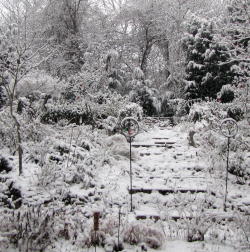
Practically pragmatic, reality based, that is the way I now garden. Oh, there are flights of fancy, reaching way past our limits, a certain fearlessness to the methods used here, to be sure. But like the yin to the yang, we want to succeed and will therefore make the changes necessary to help that success become reality.

The garden of our dreams is an English cottage type, overflowing with flowers, lush with greenery growing happily in a moist climate, like we saw at Stockton Bury, England, click here to see our story about it. Southeast Tennessee used to be a lot more moist, but with each passing year it seems to be drying up. We are turning into Southwest Texas, from whence we came before moving into this house, except our winters are colder.

The evergreen Rhododendrons that at one time grew beautifully here have given up. Most of the roses have gone belly up, one by one. Hostas and astible frizzle and burn once summer gets going. Spring is still sweet, but summer is harsh. It is time for a rethink in the plantings. Again. Above is my favorite plant of all, the deciduous azaleas, blooming in April. Natives here, they seem happy enough, unlike their evergreen cousins from cooler and wetter climes.

Earlier the rethink was about less maintenance and planting masses of what does well here. Going to more Xeric choices that can still withstand wet and soggy and sometimes frozen ground in the cold months fits the pattern that is now the way of it. The photo is an alpine garden display seen during the English Malvern Garden Show in 2010, click here to see more.

Grasses and gravel, natives and needles,…. succulents! I know very little about succulents, but I am trying to learn which ones will grow best in these conditions. Hardy seems to be a relative term, depending on many things besides temperatures, like dryness. Above: Pink muhly grass, Muhlenbergia capillaris is very happy here, even though it is native to the sandy shores of the Gulf Coast.

We began with trepidation by planting Yuccas. I dislike sharp and pointy, although roses are like that, too. The evergreen and colorful cultivar Yucca filamentosa ‘Color Guard’ was purchased and planted. It did well. We added more. This was the gateway drug, for now we have added…(hint in the opening photo)…

…Agaves. Talk about your sharp and pointy. But after seeing the Century plant, Agave americana blooming at the beach this year, and seeing a couple of plants for sale at the local big box, well, you could say we jumped in with both feet. Added so far and planted up in pots are Agave lophantha ‘Quadricolor’ in the first photo and Agave parryi truncata above. Wish me luck,please, with this new venture!
Frances









It is difficult to come to the realization that many of the plants we love are no longer surviving in our gardens. I am slowly making changes. Astilbe is a plant I regretfully am going to have to give up, way too hot most summers to even notice the flowers.
Eileen
Good luck with the agaves, Frances. I was/am not a big fan of them, but if it is the right plant in the right place, I think even I could learn to like them.
You quite right about having to rethink our gardens. I can’t grow astilbes either. Hostas usually do alright but this year and I hope it is just this year is the exception. I am losing many of my hostas. It is all a little scary. I I would love to grow some of those succulents. Very few can withstand my winters. I just love them spikes and all. I think the texture they can bring to your garden is the best thing about them. I will look forward to seeing how your garden evolves.
A sobering post, Frances. I am behind the curve on all this since I am able and willing to water my postage stamp size garden. Whether that is a responsible use of resources is another thing. I will do just about anything to keep my hostas, which are doing surprisingly well considering the record heat this year. It isn’t August yet, though. I don’t think I can plant a yucca….yet. But yours is stunning. I’ll keep an open mind. I do love my succulents in troughs and pots. Keep those thought-provoking ideas coming.
Frances, two massive thunderstorms passed by over the last 3 days – missing us completely. Yesterday our weather was warmer than Dallas Texas. (And I can assure you I did not come close to looking as lovely as those southern gals do) Where I was able to spread plants out with overlapping care-requirements, I’m going to have to coral them so I can tend to them carefully. Yet another design challenge. I’m wondering if you might be able to grow some of those wonderfully whacko echiums I saw in G.B. It might be a group to consider – they seem to take some shade and lots and lots of heat and dry – and have good blues, pinks & I think the odd white. I guess being biennial, you might lose the odd one over the winter, but if all goes well, I’d have two reasons to be jealous – ability to grow Echium pininana and muhly grass.
Barbarapc
As some of your commenters have observed, this is a sobering post and yet, since it is accompanied by such delightful pictures, I am not depressed on your behalf. The gardener in you has a strong survival instinct and you will adapt. Ha, and I, your humble reader will benefit since I share many of your climate challenges as a fellow east Tennesseer. I got bitten by the succulent/sedum bug for container gardening about a month ago and have no idea if some of my darlings will make it through our winter when I find a place to transplant them into the ground this fall. I guess to give them them their best chance to survive I should create a raised bed with gravel and excellent drainage….right?
Love that quadricolor Agave! Mine is growing so slowly, it makes a snail’s pace look fast.
I have been rethinking plantings for the last few years in designing gardens. The climate change in our area has been quite drastic in the last three years and you are very correct in that it is far more than temperature. The sun quality has gotten more brutal with increased UV wavelengths and plants seem to be just baking. Ultraviolet radiation is affecting negatively the plants ability to use and store energy if I remember correctly. Above 90° the plants lose much ability to uptake water and a plant’s temperature usually runs just above air temp. So this means our sun lovers are better in shady conditions during this time of year. Subsequently, plants get further stressed and are more susceptible to insect, viral and fungal attacks. Lack of water compounds these conditions tenfold. I am so saddened by what I see in our bread belt. We all pay the price in the end, even areas such as mine, which is a bit better off. We have had very little rain, but the temps are generally in the mid-eighties which keeps plants growing.
Beautiful agaves! Are there small ones that will fit in between stones like hens and chicks?
It’s been a rough year here in Ohio. This is the hottest dryest summer I can remember. We are not used to 100 degree heat. Most summers we don’t get over 90. Worse than the heat is the lack of rain. We have had a trace of rain in two months.
My astilbe, ferns and some of my hostas are toast. My white hydrangeas I wanted to use in my daughters wedding are fried. I’m so frustrated with gardening this year!
Succulents are becoming very popular. Agree with you on the yucca. Not a fan of them!
I didn’t start out liking succulents either…but I now have them all over the place! And a year ago I got my first agave. Yes to the sharp and pointy, but I have decided they really are cool. I just need to keep them where kids can’t get too close!
Welcome! The agave water is fine. Seriously, I fell in love in Raleigh, and so far, mine are doing well in containers. Because our winters can be even more harsh than those in Tennessee–remember the negative 17F winter before last–I bring them indoors. They sit in a window all winter, and then I bring them back outdoors. I’m with you. We must plant what works.
This summer has been a huge wake-up call all over the country, it seems. I’m not ready to give up on the astilbes, but they will be moved. They are front and center in one area of the garden, and at this point it’s a complete waste of space. After they’re moved, nature will take her course with them. Only one bloomed this year anyway, and the bloom is puny. And that’s after several years of poor performance from all of them. Some have already disappeared.
Love your strategy Frances. A pragmatic approach is so much less stressful than fretting over the way of things, or running around with hoses and watering cans (trying) to put out fires.
I don’t have an irrigation system either. Went on a vacation to come home to lots of dead plants … although rain was in the area (on the radar) every day it just kept missing my garden. I’m planting more of the things that did survive … grasses, purple coneflowers, and oxalis among others. It is a sobering subject but one we must continue to deal with and adapt to. Thanks for your wonderful blog, I really enjoy it.
I can see it now… you getting plant advice from Pam of Digging! You’ll be an agave advocate in no time! 😀
This year has definitely got me thinking about planting smartly… Watering my yard almost daily is getting to be a tasking job… To add insult to injury I just bought a bunch of plants a week or so ago, and am waiting now till a couple of days of overcast to plant them… don’t want anything perishing! I’ll learn, one day…
Last year we were inundated with rain on our hill in western Massachusetts. It is not only drought that is a problem but the violent alternating kinds of weather. We have a well so can do very little watering. My poor roses and astilbes.
Good luck with the agaves! I planted my first this year too. I hope they grow well for you. I have to admit, I was completely non-plussed at your first photo, knowing you favor a blowsy cottage garden. We are getting a string of thunderstorms here in the PNW right now, which is extremely unusual for this part of the country. So much change going on, it’s hard to know how to deal with it.
This year certainly has me thinking about change . The high temps are hard on the both the garden and the gardener. The last two years I have found it very hard to work outside in the heat. I purchased a yucca this year. It is growing in a pot for this summer while I decide where it will go. The change will be gradual but it will happen.
I hear you, Frances. Southern Wisconsin was in the grips of the horrible drought until last night. We’d had a fraction of an inch of rain since May, and now in just over 24 hours we’ve receive several inches. No floods or landslides that I know of, but that is a concern with all the hard, dried out ground. Strange to have such extremes! The Hostas in the sun burned, but the ones in the shade persevered even during the drought. Ferns are gone, Daylilies shine no matter what. I feel like the garden has been pushed to the extremes this summer, and I am definitely learning which plants are tough no matter what. Thanks for this thought-provoking post.
Frances, you get it for sure. But more than anything I want to compliment you on your garden! It’s really exceptional for your climate, and not to mention beautiful. I used to live in Tennessee and I had real trouble with keeping that level of luscious. Usually the heat made a couple plants or more a season give out or wilt beyond repair.
I like agaves. They are quite exotic for me here in Finland. We have had far too much rain. So much that plants are suffering from it.
I’ve been thinking along the same lines Frances, all future plantings must be drought tolerant! I don’t mind watering summer annuals, but anything more permanent should not be so thirsty. I really need to face the fact that our summers in central Ohio are going to be dry. I thought I had done so well with echinacea, rudbeckia, sedums, grasses. But mixed in are other plants that just don’t fit in the new climate. Time to regroup.
You have described perfectly where we are headed…pragmatic gardening…natives that will survive and removal of things that no longer do well in our changing drier climate as well…I love succulents as I lived in AZ , but we are still too cold for many for them.
Nothing like climate change to get a conversation going… There sure have been many comments here. We tend to cyclical weather in SA, periods of national drought alternating with wetter periods, each 7-10 years long and we now know El Nino is the cause of our drought cycles. This year has been, if not the driest on record, the one with the least rain-days: perhaps 25% of normal… and El Nino is only now becoming a reality…
As far as succulents go, my frustration is also that few survive my winter frosts. And many battle in my wet summers. But a stalwart here, and it should do for you, is Aloe saponaria which I posted on this week at http://sequoiagardens.wordpress.com/2012/07/15/the-past-is-sepia-the-present-is-bright/ . In theory there are many plants that can deal with below freezing temps for short periods (overnight) if they are relatively dry – but not many are freely available here, let alone in the USA!
Good Luck with your new additions! There are several Yucca’s growing ever so nicely across the street from us along the woods edge. Wooded lot left to nature and I am eyeing those beauties and think they should be in my garden. But I fear the pain from taking on these poking plants….
Hahahaha, I currently have two agave and three yucca sitting in the holding area. Love the Muhly grasses already in the area where these newbies will be added.
My azalea ‘Admiral Semmes’ is not doing well in the heat. Hoping to keep it going through the rest of the summer. Think if he lives through to September, he will be ok.